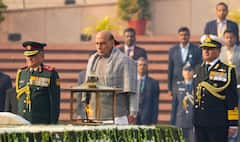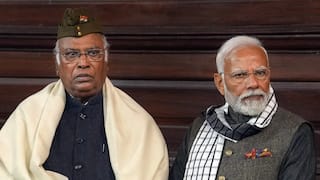Heatwave Claims 2 Lives In Rajasthan, Phalodi At 50°C Records India's Highest Temperature Since 2019
The India Meteorological Department (IMD) reports that it's the highest temperature recorded in the country since Churu, Rajasthan hit 50.8 degrees Celsius on June 1, 2019.

Temperatures in Rajasthan's Phalodi soared to a blistering 50 degrees Celsius on Sunday, as a severe heatwave affected large parts of India, challenging millions, including those voting in the sixth phase of the general elections. According to the India Meteorological Department (IMD), this is the highest temperature recorded in the country since Churu, Rajasthan hit 50.8 degrees Celsius on June 1, 2019. Phalodi previously recorded India's all-time high temperature of 51 degrees Celsius on May 19, 2016.
Notably, 2 heatwave-related deaths were reported in Rajasthan.
As per news agency PTI, the extreme heat impacted not only the northern plains and central regions of the country but also the hilly areas of Himachal Pradesh, Assam, and Arunachal Pradesh.
Rajasthan health department confirmed the death of a 40-year-old man due to heatstroke on Sunday. Moti Singh, a labourer in a Roopangarh marble factory, fell ill while working on Saturday and was hospitalised. He was transferred from CMC Roopangarh to Ajmer's Kishangarh Hospital where he was pronounced dead, as per the health department's report issued on Sunday.
Meanwhile, in Bundi city, 26-year-old Ashish Boyat, a resident of Guru Nanak Colony, was found deceased in his home. While his family suspects heatwave as the cause, police are awaiting the autopsy report to confirm the cause of death, stated Bundi city SHO Tejpal.
Thousands of voters braved the scorching temperatures during the sixth phase of the Lok Sabha elections. Amid polling, many voters stood in long, unshaded queues, and some polling booths lacked water, coolers, and seating for the elderly, worsening the heat's impact. Even several voters fainted in Delhi due to the severe heatwave.
West Bengal's Cooch Behar (40.5 degrees), Assam's Silchar (40), and Lumding (43), and Arunachal Pradesh's Itanagar (40.5) and Pasighat (39.6) recorded their highest temperatures ever. Assam's Tezpur (39.5), Mazbat (38.6), Dhubri (38.2), North Lakhimpur (39.2), and Mohanbari (38.8) also saw record-breaking May temperatures.
Official data indicated that at least 17 places in Punjab, Haryana, Rajasthan, Uttar Pradesh, Gujarat, and Madhya Pradesh recorded maximum temperatures of 45 degrees Celsius or above on Saturday. In Rajasthan, temperatures touched 48.8 degrees Celsius in Barmer, 48 degrees in Jaisalmer, and 47.2 degrees in Bikaner, prompting the state's disaster management department to instruct district collectors to provide relief to people, animals, and birds.
The extreme heat will continue in parts of Delhi, Rajasthan, Punjab, Haryana, Chandigarh, Uttar Pradesh, Madhya Pradesh, Gujarat, Chhattisgarh, and Maharashtra until May 29, also affecting the hills of Himachal Pradesh, Assam, and Meghalaya.
IMD Issues 'Red Alert' For Rajasthan, Punjab, Haryana, Chandigarh, Delhi
A 'red' alert has been issued for Rajasthan, Punjab, Haryana, Chandigarh, Delhi, west Uttar Pradesh, and Gujarat, indicating a "very high likelihood" of heat-related illnesses and heatstroke across all age groups.
The IMD warned that warm night conditions could exacerbate heat-related stress in Uttar Pradesh, Punjab, Haryana, Delhi, and Rajasthan over the next four days. Urban areas are especially affected due to the urban heat island effect, where cities are significantly hotter than their surroundings.
Akash Vashishtha, founder-secretary of the Society for Protection of Environment and Biodiversity, explained that urban areas like Delhi-NCR become "heat chambers" due to land and surface concretisation, producing a heat multiplier effect.
Incoming solar radiation, when reflected off the land surface, finds limited open space to dissipate into the upper atmosphere. The heat becomes trapped by horizontal and vertical concrete structures, which significantly increase ambient temperatures, he explained.
According to Vashishtha, quick action is required to maintain vegetation on ground surfaces to absorb solar radiation and lessen heat radiation and reflection from land surfaces. In parts of India, the oppressive heat is creating drought-like conditions by drying up water bodies and stressing power grids.
As per the Central Water Commission, water storage in 150 major reservoirs in India plunged to its lowest level in five years last week, worsening water shortages and significantly affecting hydropower generation. Water levels in the Delhi stretch of the Yamuna River have dropped, impacting water supply, while the power demand of the city reached a record 8,000 megawatts on Wednesday as air conditioners, coolers, and refrigerators ran at full capacity.
Severe and frequent heatwaves are particularly hard on low-income households with limited access to water and cooling, and outdoor workers who must take frequent breaks to avoid heat exhaustion and heatstroke. Anna Walnycki of the International Institute for Environment and Development highlighted that low-income households have limited capacity to adapt to extreme heat due to poor access to water and electricity, and poorly ventilated homes.
Over 1,66,000 People Died Of Heat Waves Between 1998 And 2017: WHO
The World Health Organisation reported that more than 1,66,000 people died as a result of heat waves between 1998 and 2017. India reported 3,812 deaths due to heat waves between 2015 and 2022, with Andhra Pradesh alone leading 2,419 fatalities.
Shyamal Santra of the NGO Transform Rural India stated that students who go through a "hot school year" do less well on exams than those who go through a "cool school year." "With 15 percent of government schools in India not having a functional electricity connection and many being single-classroom schools, heat waves disproportionately affect rural educational outcomes," he said.
Without sufficient cold-chain infrastructure, extreme heat can significantly damage fresh produce. Studies indicate that India incurs food losses amounting to USD 13 billion annually, with only four percent of fresh produce being protected by cold chain facilities.
World Bank's analysis estimates that by 2030, the productivity decline linked to heat stress will cause 80 million job losses worldwide, 34 million of which are expected to occur in India.
Trending News
Top Headlines






































